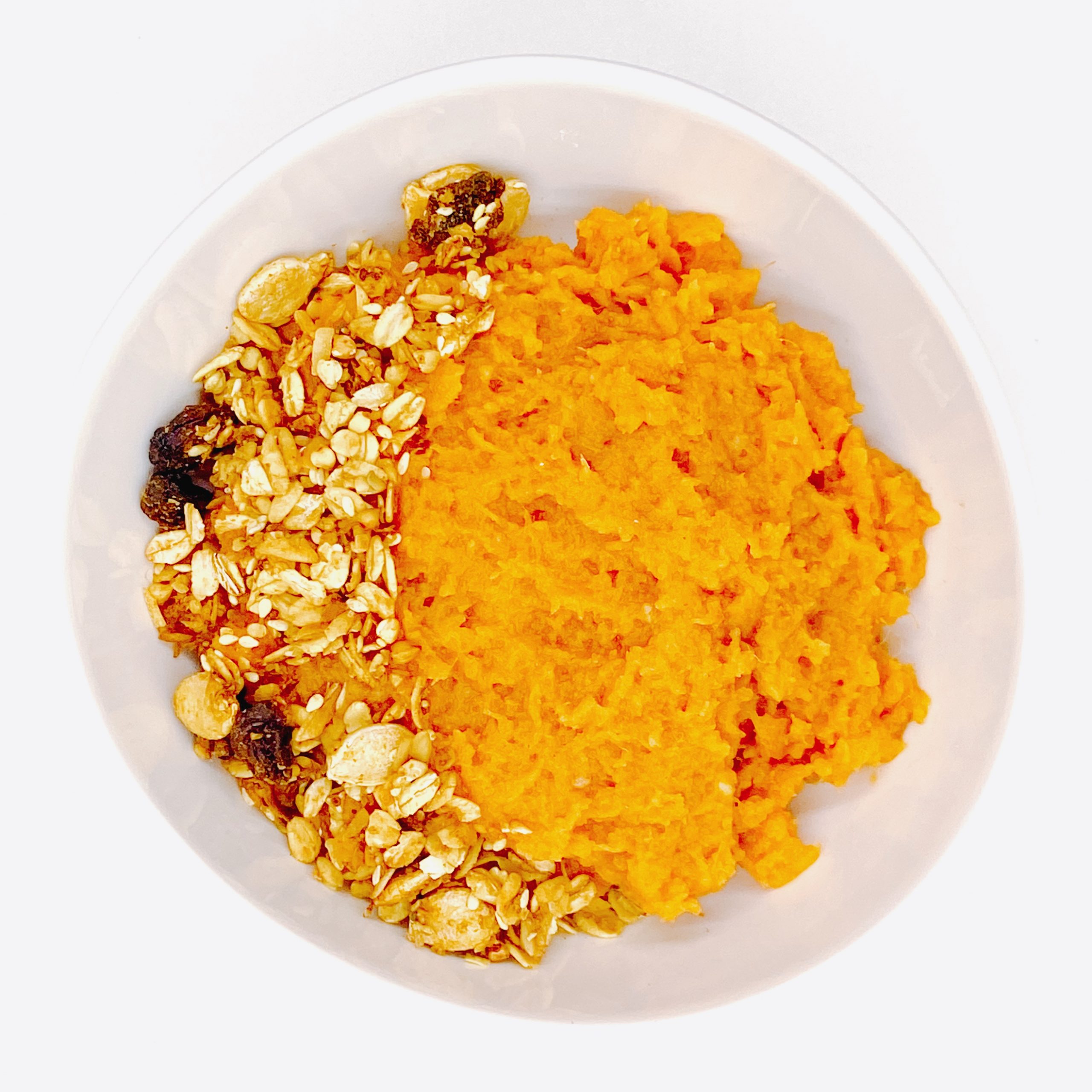Mashed yams, savory granola, blueberries
Breakfast can be chaotic, even without a newborn in the mix. At Nourish, we make sure that your first meal of the day is packed with all the nutrients you need to start your day on the right foot without having to think about it. Keep reading for the Mashed yams, savory granola, blueberries nutritional informations, storage and other instructions.
This breakfast item must be store in the refrigerator and eaten warm or room temperature.
Reheat mashed yams in a microwave for 1 minute or in a pot on the stovetop as you would oatmeal. Sprinkle granola and blueberries on top before serving.
Mashed yams, savory granola, blueberries Ingredient List :
Mashed Yams : yams, maple syrup, cinnamon, nutmeg, ginger
Savory Granola : flax meal, rolled oats, raw buckwheat groats, raw pumpkin seeds, raw sunflower seeds, sesame seeds, coconut flakes, golden raisins, sea salt, turmeric, cumin, curry powder, cinnamon, cayenne pepper, coconut oil, maple syrup
CONTACT US IF YOU HAVE ANY QUESTIONS.
About the Mashed yams, savory granola, blueberries Ingredients
Yams :
Yams come in a variety of sizes and colors — including orange, white, and purple — and are rich in vitamins, minerals, antioxidants, and fiber.
They are a great source of fiber, vitamins, and minerals.
One cup (200 grams) of baked yams with skin provides :
- Calories: 180
- Carbs: 41.4 grams
- Protein: 4 grams
- Fat: 0.3 grams
- Fiber: 6.6 grams
- Vitamin A: 769% of the
Daily Value (DV) - Vitamin C: 65% of the DV
- Manganese: 50% of the DV
- Vitamin B6: 29% of the DV
- Potassium: 27% of the DV
- Pantothenic acid: 18% of the DV
- Copper: 16% of the DV
- Niacin: 15% of the DV
In addition, yams — especially the orange and purple varieties — are rich in antioxidants that protect your body from free radicals. Free radicals are unstable molecules that can damage DNA and trigger inflammation.
Free radical damage has been linked to chronic illnesses like cancer, heart disease, and aging. Therefore, eating antioxidant-rich foods is good for your health.
The fiber and antioxidants present in yams promote the growth of good gut
bacteria and contribute to a healthy gut.
Yams are also an excellent source of beta-carotene, which can be converted to
vitamin A and help support your immune system and again, gut health.
Flax :
- Omega-3 essential fatty acids, “good” fats that have been shown to have heart-healthy effects. Each tablespoon of ground flaxseed contains about 1.8 grams of plant omega-3s.
- Lignans, which have both plant estrogen and antioxidant qualities. Flaxseed contains 75 to 800 times more lignans than other plant foods.
- Fiber. Flaxseed contains both the soluble and insoluble types.
Oats :
Oats are rich in carbs and fiber, but also higher in protein and fat than most other grains.
They are very high in many vitamins and minerals (for 1/2 cup or 78g of oats) :
- Manganese: 191% of the RDI
- Phosphorus: 41% of the RDI
- Magnesium: 34% of the RDI
- Copper: 24% of the RDI
- Iron: 20% of the RDI
- Zinc: 20% of the RDI
- Folate: 11% of the RDI
- Vitamin B1 (thiamin): 39% of the RDI
- Vitamin B5 (pantothenic acid): 10% of the RDI
- Smaller amounts of calcium, potassium, vitamin B6 (pyridoxine) and vitamin B3 (niacin)
Raw buckwheat groats :
Almonds boast an impressive nutrient profile. A 1-ounce (28-gram) serving of almonds contains :
- Fiber: 3.5 grams
- Protein: 6 grams
- Fat: 14 grams (9 of which are monounsaturated)
- Vitamin E: 37% of the RDI
- Manganese: 32% of the RDI
- Magnesium: 20% of the RDI
Almonds are high in antioxidants that can protect your cells from oxidative damage, a major contributor to aging and disease.
They are among the world’s best sources of vitamin E, with just 1 ounce providing 37% of the RDI.
These amazing tree nuts are extremely high in magnesium, a mineral that many people don’t get enough of. High magnesium intake may offer major improvements for metabolic syndrome and type 2 diabetes. Magnesium is a mineral involved in more than 300 bodily processes, including blood sugar control.
“Bad” LDL cholesterol can become oxidized, which is a crucial step in the development of heart disease. Snacking on almonds has been shown to significantly reduce oxidized LDL.
Turmeric :
Turmeric has been used in India for thousands of years as both a spice and medicinal herb. Recently, science has started to back up traditional claims that turmeric contains compounds with medicinal properties.
These compounds are called curcuminoids. The most important one is curcumin.
Curcumin is a substance with powerful anti-inflammatory and antioxidant properties.
Moreover, It can increase the antioxidant capacity of the body as well as help against depression.


Leave a Reply